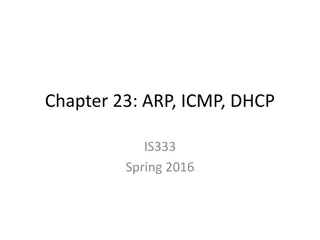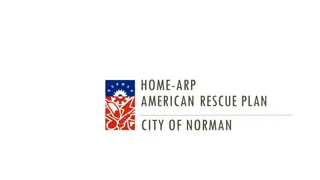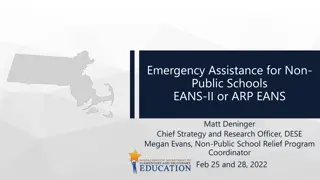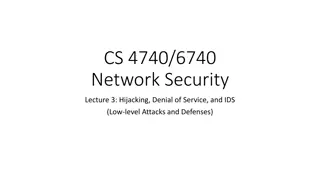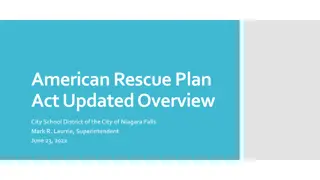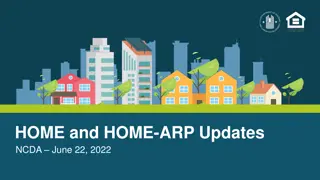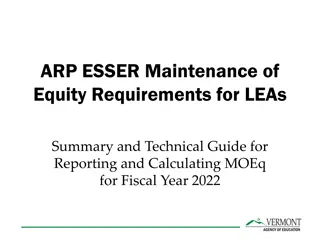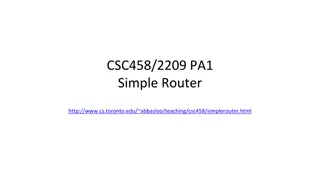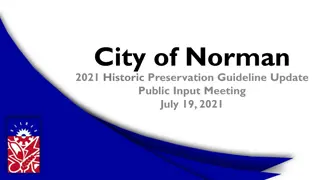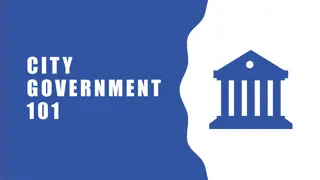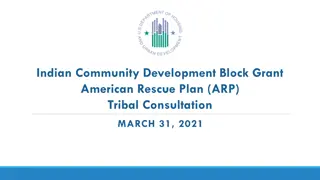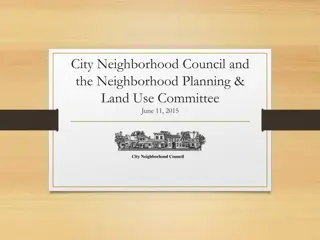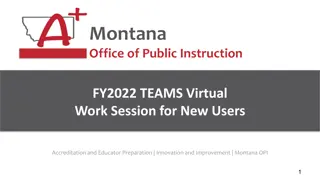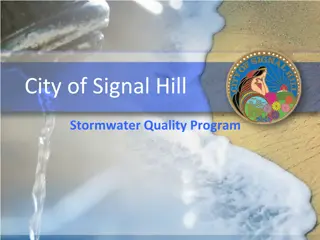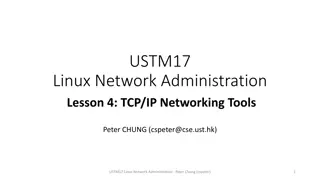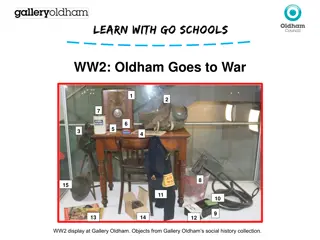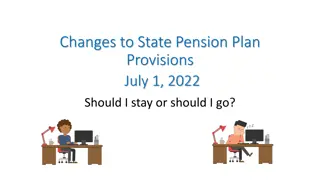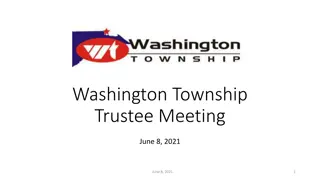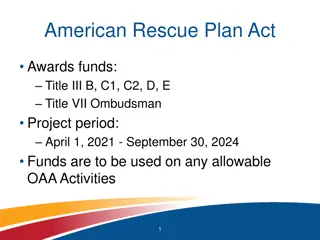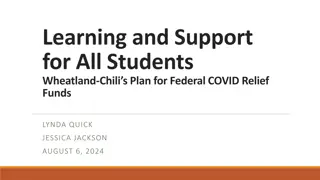Overview of HOME-ARP Program in City of Norman
The HOME-ARP program in the City of Norman aims to provide housing, rental assistance, and supportive services to homeless individuals and vulnerable populations. With a total allocation of $1,560,908, the program focuses on consultation, public participation, needs assessment, and production housing goals. Activities include administration, planning, operating costs, and capacity building. The application process involves signing and returning grant agreements to HUD, developing and submitting an Allocation Plan, and beginning program execution upon HUD approval. Grants expire in 2030, with compliance continuing based on activity type.
Download Presentation

Please find below an Image/Link to download the presentation.
The content on the website is provided AS IS for your information and personal use only. It may not be sold, licensed, or shared on other websites without obtaining consent from the author. Download presentation by click this link. If you encounter any issues during the download, it is possible that the publisher has removed the file from their server.
E N D
Presentation Transcript
HOME-ARP AMERICAN RESCUE PLAN CITY OF NORMAN
INFORMATIONAL SUMMARY What is HOME-ARP? The application process Qualifying populations Developing the HOME-ARP Allocation Plan Eligible activities What is currently being undertaken?
SEC. 3205. HOMELESSNESS ASSISTANCE AND SUPPORTIVE SERVICES PROGRAM. Provides $5 billion of supplemental HOME funds to assist individuals or households who are homeless, at risk of homelessness and other vulnerable populations by providing housing, rental assistance, supportive services, and non-congregate shelter. THE HOME- AMERICAN RESCUE PLAN (ARP)
HOME-ARP-CPD Notice 21-10 99 page document with details needed to develop HOME ARP Plan and determine gaps and priorities Allocated via HOME formula, highly targeted to poverty, renters in poverty; cost, availability and condition of housing stock Jurisdictions that qualified for HOME allocation in FY 2021 received HOME-ARP allocation
HOME-ARP ALLOCATION City of Norman $1,560,908 Consultation & Public Participation Needs Assessment and Gaps Analysis HOME-ARP Activities HOME-ARP Production Housing Goals Preferences
ACTIVITY CAPS Up to 15% of funds can be used for Admin and planning for Participating Jurisdictions or subrecipients Up to 5% of funds can pay for operating costs (e.g. salaries, insurance, utilities, etc.) for CHDOs and other non-profits undertaking HOME-ARP activities An additional 5% for capacity building costs to allow PJs to expand capacity of CHDOs or other non-profits
APPLICATION PROCESS 01 02 03 04 Sign and return HOME-ARP Grant Agreements to HUD. Once the grant agreement is returned, HUD will release in IDIS, 5% of the total grant amount for a portion of the administration and planning. ($78,045.40 executed 12/14/2021) PJs will develop and submit in IDIS a HOME- ARP Allocation Plan as part of a substantial amendment to their FY 2021 AAP and submit to HUD by 3/31/2023 PJs will begin programmatic execution and distribution of funding once HUD approval of Allocation Plan is complete. Grants expire September 30, 2030. Period of Compliance continues depending on activity type.
QUALIFYING POPULATIONS Fleeing, or attempting to flee, domestic violence, dating violence, sexual assault, stalking, or human trafficking, as defined by the Secretary; At-risk of homelessness, as defined in section 401(1) of the McKinney-Vento Homeless Assistance Act Homeless, as defined in section 103(a) of the McKinney-Vento Homeless Assistance Act In other populations where providing supportive services or assistance under section 212(a) of the Act (42 U.S.C. 12742(a)) would prevent the family s homelessness or would serve those with the greatest risk of housing instability; Veterans and families that include a veteran family member that meet one of the preceding criteria.
OTHER POPULATIONS Where providing services or assistance under section 212(a) of NAHA (42.U.S.C. 12742(a) would prevent the family s homelessness or would serve those with the greatest risk of housing instability Previously documented as homeless or currently housed due to temporary or emergency assistance according to 24 CFR 91.5 to avoid returning to homelessness At greatest risk of housing instability including: Less than 30% MFI Paying more than 50% of household income toward housing costs Meet one of the following conditions from paragraph (iii) of At risk of homelessness established in 24 CFR 91.5
an individual or family who lacks a fixed, regular, and adequate nighttime residence; an individual or family with a primary nighttime residence that is a public or private place not meant for human habitation, including a car, park, abandoned building, bus or train station, airport, or camping ground; HUD DEFINITION HOMELESS an individual or family living in shelter designated to provide temporary living arrangements an individual who resided in a shelter or place not meant for human habitation and who is exiting an institution where he or she temporarily resided; an individual or family who will imminently lose their housing, including housing they own, rent, or live in without paying rent, are sharing with others, and rooms in hotels or motels
Multiple Moves: Has moved because of economic reasons two or more times during the 60 days immediately preceding the application for assistance Doubled Up: Is living in the home of another because of economic hardship HUD DEFINITION AT RISK OF HOMELESSNESS Hotel/Motel: Lives in a hotel or motel and the cost is not paid for by charitable organizations or by federal, state, or local government programs for low-income individuals Overcrowded Housing: Lives in a single room occupancy (SRO) or efficiency apartment unit where two or more persons reside or where there are more than one-and-a-half persons per room Income at or below 30% AMI; Lacks sufficient resources to attain housing stability; AND Exiting Institution: Is exiting a publicly funded institution or system of care (e.g., jail, prison, psychiatric hospital, etc.);
PLANNING FOR HOME-ARP Who are the key players and how engagement occurs.
PARTICIPATING JURISDICTION (PJ) - City of Norman State and local government agencies that administer HOME funds. PJs are given broad discretion in determining how HOME funds are spent, although there are prohibited activities. HOME projects and activities in nonmetropolitan and rural areas are generally funded through state PJs (OHFA).
PJS RESPONSIBILITIES Managing the day-to-day operations of the HOME-ARP program Ensuring that HOME-ARP funds are used in accordance with all program requirements and written agreements Completing and submitting the Allocation Plan Set up written agreements, policy and procedures and other grant management activities Taking appropriate action when performance problems arise
CONTINUUM OF CARE (COC) OK504 Collaborative Applicant Thunderbird Clubhouse Board, Inc. The CoC is the planning body made up of stakeholders in a community with an interest in preventing and ending homelessness within their geographic region. They are responsible for operating the homeless system in a community to provide for crisis and housing services to people experiencing homelessness.
COC RESPONSIBILITIES Coordinating community funding and services for people experiencing homelessness Strategically coordinating all public and private funding sources in a community to address the needs of persons experiencing homelessness Developing targeted partnerships with housing providers and supportive services providers Utilizing data to improve the homeless system and ensure that homelessness is rare, brief and non-recurring
The City of Norman as the PJ will consult with OK504 CoC to identify community priorities for HOME-ARP projects. Provide data to support the needs of the community, which will be required in the HOME- ARP Allocation Plan; PIT, HIC, BNL Possible partners for the supportive services provided to residents of HOME-ARP projects COC INVOLVEMENT IN HOME-ARP Be an advocate for, or an adversary against, eligible projects Operate the Coordinated Entry, which could be used as a source for referrals
DEVELOPING THE HOME-ARP ALLOCATION PLAN
COMPONENTS OF THE ALLOCATION PLAN Needs Assessment and Gap Analysis Consultation HOME-ARP Activities Activity Specific Requirements Public Participation Certifications and SF-424s
CONSULTATION The City of Norman PJ will consult with agencies and services providers whose clientele include HOME-ARP qualifying populations to identify unmet needs and gaps in housing and service delivery systems. At a minimum these include: 1. OK504CoC which serves the jurisdictions geographic area 2. Homeless and domestic violence service providers 3. Veteran s groups 4. 5. Public housing agencies Public agencies that address the needs of the qualifying populations 6. Public or private organizations that address fair housing, civil rights, and the needs of persons with disabilities.
NEEDS ASSESSMENT AND GAP ANALYSIS The City of Norman as the PJ will conduct a needs assessment and gap analysis, both rooted in data. Part of the analysis must include the size and demographics of the qualifying population and the unmet need in housing and services. In addition, the plan will: 1. Identify the characteristics of housing associated with instability and an increased risk of homelessness. Identify priority needs for qualifying populations; and, 2. The data MUST drive the decision on how HOME- ARP funds will be allocated. 3. Explain how level of need and gaps in its shelter and housing inventory and service delivery systems was determined.
HOME-ARP ACTIVITIES Describe how a PJ will distribute HOME-ARP funds in accordance with its priority needs. Indicate the amount of HOME-ARP planned for each eligible activity type. Demonstrate that no more than 5% of the allocation will be used for nonprofit organization operating assistance, nonprofit capacity building, and no more than 15% for administrative costs. Include a description on how the characteristics of the shelter and housing inventory, service delivery system, and the needs identified in the gap analysis provided a rationale for the plan to fund eligible activities.
ACTIVITY SPECIFIC REQUIREMENTS HOME-ARP Production Goals: Preferences: HOME-ARP Refinancing Guidelines: If a PJ intends to use HOME-ARP funds to refinance existing debt secured by multifamily rental housing that is being rehabilitated with HOME-ARP funds, it must state its refinancing guidelines in accordance with 24 CFR 92.206(b). The plan must estimate the number of affordable rental housing units for qualifying populations that the PJ will produce and describe a specific affordable rental housing production goal and how it will address the PJ s priority needs. The plan must identify whether the PJ intends to give preference to one or more qualifying populations or a subpopulation within one or more qualifying populations for any eligible activity or project.
PREFERENCES/LIMITATIONS/METHODS OF PRIORITIZATION A Preference permits an eligible Qualified Population applicant to be selected for assistance before another eligible qualifying applicant. A Limitation purposefully excludes an eligible Qualified Population applicant from applying for or receiving assistance A Method of Prioritization is the process used to determine how two or more eligible Qualified Population applicants qualifying for preferences are selected for HOME-ARP assistance.
PUBLIC PARTICIPATION At a minimum a PJ must: 1. Provide residents with reasonable notice and an opportunity for public comment on the proposed HOME-ARP allocation plan for at least 15 days. Official comment period is scheduled for March 1-17, 2023; but all comments made during the consultation period will be recorded and considered. 2. Follow its adopted requirements for reasonable notice and an opportunity to comment for plan amendments in its current citizen participation plan. 3. Hold at least one public hearing during the development of the HOME-ARP allocation plan prior to submitting the plan to HUD. (December 14, 2022; January 4, 2023; March 27, 2023)
CERTIFICATIONS AND SF-424S Submit an SF-424, SF-424B, and SF-424D and the required certifications with the HOME-ARP allocation plan, including the following: 1. Affirmatively Further Fair Housing 2. Uniform Relocation Assistance and Real Property Acquisition Policies Act and Anti-displacement and Relocation Assistance Plan 3. Anti-Lobbying 4. Authority of Jurisdiction 5. Section 3 6. HOME-ARP specific certification that a PJ will only use HOME-ARP funds consistent with ARP and the HOME-ARP Notice for eligible activities and eligible costs.
FIVE ELIGIBLE ACTIVITIES PRODUCTION OR PRESERVATION OF AFFORDABLE HOUSING (HOME ELIGIBILITY) TENANT-BASED RENTAL ASSISTANCE (TBRA) (HOME ELIGIBILITY) SUPPORTIVE SERVICES, HOMELESS PREVENTION SERVICES, AND HOUSING COUNSELING (HOME ARP ELIGIBILITY ONLY) PURCHASE AND DEVELOPMENT OF NON- CONGREGATE SHELTER (HOME ARP ELIGIBILITY ONLY) NONPROFIT OPERATING AND CAPACITY BUILDING (HOME ARP ELIGIBILITY ONLY)
HOME-ARP funds may be used to acquire, construct and rehabilitate rental housing for occupancy by individuals and families that meet one of the Qualifying Populations. RENTAL HOUSING HOME-ARP rental housing may include single family or multifamily housing, transitional or permanent housing, group homes, single room occupancy (SRO) units, and manufactured housing.
HOME-ARP funds may be used to provide tenant- based rental assistance ( HOME-ARP TBRA ) to individuals and families that meet one of the Qualifying Populations TENANT BASED RENTAL A PJ may assist a qualifying household by providing payments towards housing and housing-related costs, such as rent, security deposits, utility deposits, and utility costs ASSISTANCE
HOME-ARP funds may be used to provide a broad range of supportive services to individuals and families that meet one of the qualifying populations. McKinney-Vento Supportive Services Homeless Prevention Services (ESG Program) Housing Counseling Services SUPPORTIVE SERVICES Supportive services may be provided to individuals and families who are not already receiving the services (limited) through another program.
HOME-ARP funds may be used to acquire and develop non-congregate shelter (NCS) for individuals and families that meet one of the Qualifying Populations. NON- CONGREGATE SHELTER NCS provides private units or rooms as temporary shelter to individuals and families and do not require occupants to sign a lease or occupancy agreement. This activity may include the construction of new structures or the acquisition and/or rehabilitation of existing structures (such as motels, nursing homes, or other facilities) to be for use as HOME-ARP NCS.
HOME ARP funds may used (up to 5% of HOME-ARP allocation) to pay operating expenses of CHDOs and other nonprofit organizations that will carry out activities with HOME-ARP funds. NONPROFIT OPERATING AND CAPACITY BUILDING ASSISTANCE A PJ may also use up to an additional 5% of its allocation to pay eligible costs related to developing the capacity of eligible nonprofit organizations to successfully carry out HOME-ARP eligible activities. In any fiscal year, for both the operating assistance or capacity building assistance provided to non-profits may not exceed the greater of 50% of the general operating expense for the non-profit for that fiscal year, or $50,000. If an organization receives BOTH in a fiscal year, the total amount a non-profit may receive is the greater of 50% of their operating expense for that year or $75,000.
WHAT IS CURRENTLY BEING UNDERTAKEN? The City of Norman, OK504CoC and other community partners are collecting data to assist in identifying the priorities. 1. HMIS data on who is experiencing homelessness in the community 2. Reviewing current community plans or gaps analysis 3. Identifying additional sources of funding for potential projects as needed 4. Development of prioritization tools for potential projects


